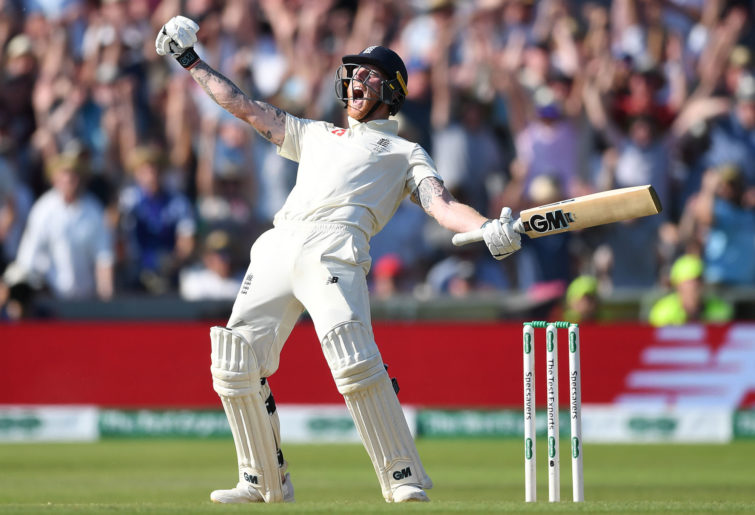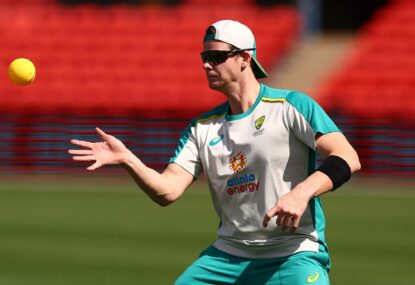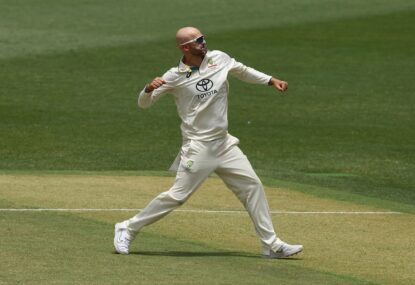Welcome back to another Ashes ’13/’14 rewind.
In the first Test, the Aussies blew England away courtesy of Mitchell Johnson (spoiler alert: It won’t be the last time) and some sublime batting. The second Test takes us to the Adelaide Oval where England are hoping for a turn in fortune.
England have dropped their steady number three Jonathan Trott to give exciting all-rounder Ben Stokes his first international cap. They also have included the services of a left-arm spinner, Monty Panesar, in an interesting decision to have two frontline spinners on these concrete strips in Australia. Since they had another fast bowler in the form of Stokes, the choice did not seem too bizarre.
Australia remained unchanged from their demolition at the Gabba and definitely changed everybody’s perspective of the series. They were on the hunt for another victory, and Johnson would prove to be their hero again.
Come join me as we take a look at what unfolded in the second Test match of the 2013/14 Ashes series.
Michael Clarke won the toss and without hesitating opted to bat first again. Warner and Rogers got off to a good start but Stuart Broad proved to be a thorn in the Australian side as he got Warner out for 29. Shane Watson did not have the best of starts to his Ashes campaign, so he was desperate for runs.
Chris Rogers was in a similar position, nevertheless the both of them put on a 121-run stand to silence the critics, both of them reaching half-centuries. Watson’s innings was brought to an end after a magnificent caught and bowl by Jimmy Anderson and Rogers fell to Graeme Swann just five balls later.
So with two new batsmen at the crease, England wanted to fortify their hold on the match but Clarke had other ideas.
Together him and newbie George Bailey ruffled English feathers and Bailey reached his first international half-century. After Bailey’s departure, Brad Haddin came to the crease and his guardian angel loomed over him after he was dropped on five by Michael Carberry, but he wasn’t ready to hit the showers just yet. After getting to his third consecutive 50 in the series, Haddin was determined to convert his start.
An eager Ben Stokes thought he had claimed his first international wicket when Haddin nicked one through to the keeper on 51 of his bowling, but it was not to be for Stokes. Unfortunately for him he couldn’t keep his front foot behind the line and Haddin lived to fight another day.

(Photo by Gareth Copley/Getty Images)
England would regret not taking their chances as he and his captain went on to compile a 200-run stand to swing the match in Australia’s favour. Captain Courageous got through to his second century of the series and cries of jubilation filled the Adelaide oval as he raised his bat to appreciate the applause.
Australia was on course for glory and he steered them towards it. Clarke eventually fell to be Ben Stokes first (legitimate) wicket with their score on 457 and there the tail was to follow to hang around with Brad Haddin, still on 86.
They stuck around for a bit and Haddin finally got to three figures, but the Australian bowlers were not going to bat forever and Haddin went after the English bowlers, getting out on 118- an outstanding knock. The Australian bowlers did, however, hang around long enough for the big man, Ryan Harris to reach fifty. A nice little accolade for a number 10.
Australia ended up declaring after 570 runs, another big mountain for the English to climb if they were to contest in this fight.
When England started to bat the openers, Alastair Cook and Carberry were greeted again by raw pace and skilful bowling. It proved to be the downfall of the England captain and Joe Root was left to face the remaining overs of Day 2 with Carberry. Australia started Day 3 on top by picking up the wickets of Root and Kevin Pietersen before lunch.
Carberry remained at the wicket and managed to grind his way to a half-century. One of England’s main problems of the series were the lack of substantial partnerships and with wickets falling at regular intervals, the motherland never really could find any rhythm in front of the wickets – although you can argue that it’s bound to be difficult when you are up against a fired-up Australian bowling attack that would make you work hard for every single run.
Mitchell Johnson once again showed his worth by picking up the wickets of Matt Prior and Broad in consecutive deliveries, but he didn’t stop there. He maintained his ruthless onslaught by dismissing the remainder of the England line up and raked his tally up to seven in the innings.
England were all out for 172, lucky enough to avoid a follow on. England’s chances of pulling one back in the series looked slim and the Aussies’ smiles kept on growing.

(AAP Image/Dave Hunt)
With a lead of 398, Australia were not planning on batting for very long and the English bowlers were not to please to be back out so early either. England’s talisman Jimmy Anderson came to the party for the first time in the series, picking up the wickets of Chris Rogers and Shane Watson in the same over.
Could there be hope for the poms? The fleeting but joyful moment was brought to a halt when Clarke joined David Warner and they, as per usual, steadied the ship towards a healthy total of 132. Australia’s lead was now 530 and the English wished that it all was just a bad dream.
Out to bat they brave soldiers came again but their courage seemed minuscule when put alongside their target of 531. It was going to be a repeat of the first match when Johnson picked up the wicket of Cook thanks a great catch in the deep.
The short pitch bowling seemed to be working for Clarke’s men. Carberry fell in the exact same fashion as his counterpart.
The temptation of a short ball that is being asked to hook seemed too much for the England batters and the catches just kept on coming. Root and Pietersen joined forces to get England’s total up to 131, with both of them reaching 50s. But the Australian bowling attack will never be out of answers and they broke the deadlock thanks to a Peter Siddle wicket.
The English batted on, but it was imminent that the gigantic target was too far out of reach. Nonetheless, they kept on fighting and wicketkeeper Prior managed to score for the first time in the series by scraping together a 50 as everybody around him kept falling. The English were inevitably bowled out for 312, losing by 219 runs.
There certainly was more to smile about for the England with them stacking up a couple of milestones, but it was still nowhere near the class and precision that the Aussies showed. Johnson, again picking up the man of the match award and certainly was one of the main concerns for Alastair Cook’s men.
Not a lot can be said for the English except that if they wanted to turn this series around they would have to come fight fire with fire in the third match and come out all guns blazing.
On the other hand, the nations that the Australians were set to tour later that year were already sitting up straight and getting their notes together on this team and especially Johnson, because they knew that if they were unprepared, they were in for one hell of a ride.
Join me next time when we travel to West Australia to witness the Aussies reclaiming the most glorious trophy in cricket.







































































































